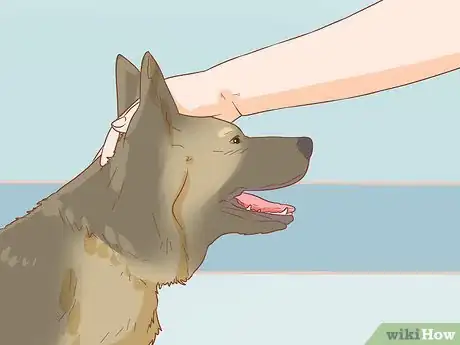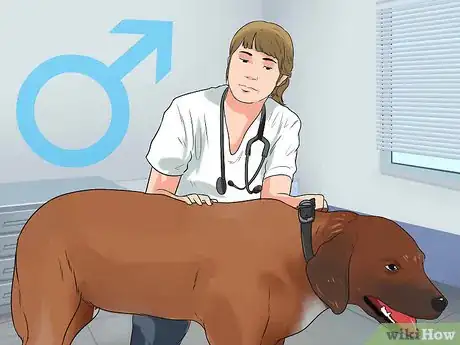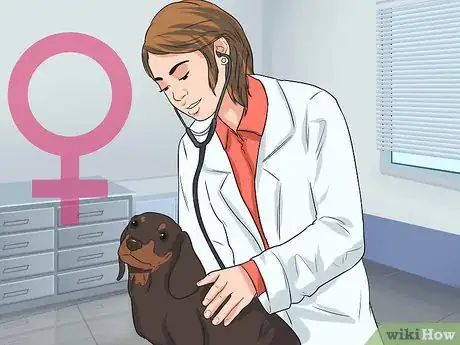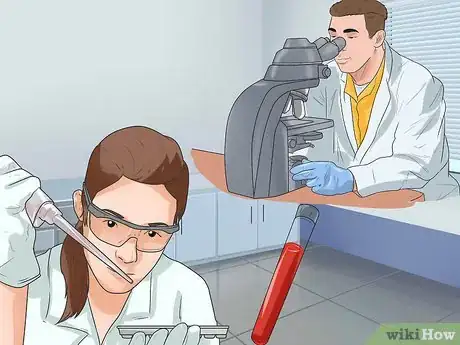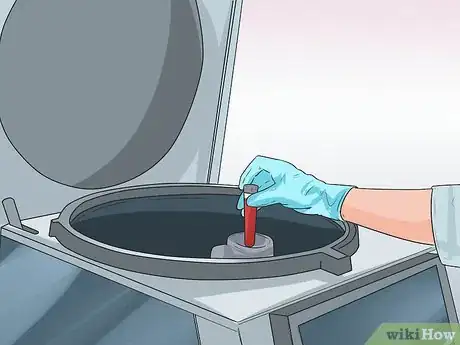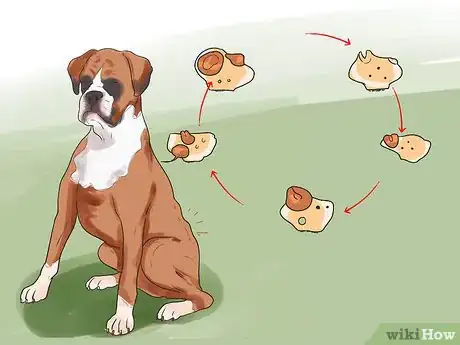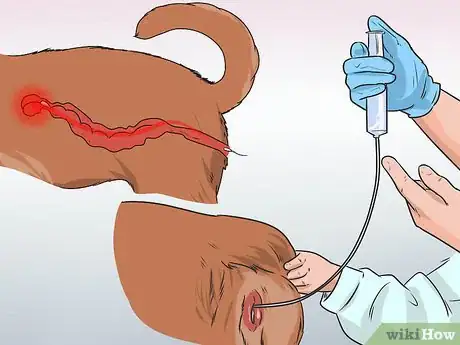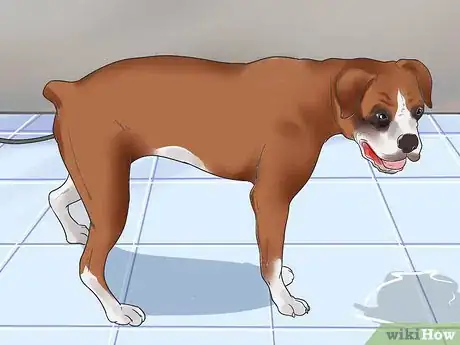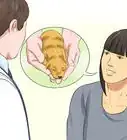This article was co-authored by John Jess. John Jess is a Dog Breeder and the Founder of Central Illinois Doodles, a family business located in Arthur, Illinois. He specializes in breeding Goldendoodles and Bernedoodles. Central Illinois Doodles has been named one of the Top 10 Bernedoodle breeders in the United States by Bubbly Pet and Pupvine. They’ve also been named one of the best Goldendoodle breeders by Trending Breeds and Devoted to Dog.
There are 8 references cited in this article, which can be found at the bottom of the page.
This article has been viewed 204,784 times.
Artificial insemination (AI) is the technique used to impregnate a female dog without that dog having sex. First semen is collected from a male dog and then it is placed into a female dog’s reproductive tract while she is fertile. This, hopefully, will result in the sperm penetrating the female's egg, and producing an embryo. While it is a technique that is performed by experienced dog breeders, it takes a lot of knowledge, skill, and practice to prefect, and so should only be done by trained professionals.
Things You Should Know
- Evaluate both dogs to confirm they're healthy enough to breed.
- Bring the male near the female when she's in heat. When he goes to mount her, redirect his penis into an artificial vagina to catch the semen.
- Chill or freeze the semen if you aren't using it immediately for insemination.
- Insert the semen into the female dog's vagina with a pipette when she's in the correct stage of her estrus cycle.
Steps
Evaluating Both Dogs
-
1Determine whether or not to use artificial insemination. Dog breeders use artificial insemination for a variety of reasons. Some breeds suffer from a diminished gene pool, especially if the country has a small number of breeding dogs.[1] If the male and female dog are separated by great distances it may be cheaper to AI than to pay for transportation for the dog and their handler.
- Artificial insemination can also make the semen from a desirable male dog more widely available.
-
2Evaluate the male dog for suitability for breeding.[2] Only dogs that are healthy and meet breed specifications for conformation and type should be bred. This helps assure that the offspring will be healthy and display the desired breed traits.
- In addition to a general health examination, a breeding soundness examination is done to make sure the male dog’s reproductive tract is healthy and sound.
-
3Evaluate the female dog for suitability for breeding. Much like the male, the female dog needs to be examined to make sure she is healthy for breeding and that she meets breed standards. A female dog that is in ill health or who has reproductive problems could have problems getting pregnant, even with AI, or could suffer severe health problems due to a pregnancy.
Collecting Dog Semen
-
1Collect the male dog's semen.[3] Once the male dog has been deemed acceptable for breeding his semen will need to be collected. Male dogs will become aroused in the presence of a female dog in heat, which is the prime time her body emits pheromones or chemicals that excite the males. When he attempts to mount, or breed, with the female the penis is redirected into an artificial vagina into which he ejaculates.
- In some cases a female at the correct stage of heat is not available. Frozen cotton swabs that were wiped in the vagina of a female dog at the peak of heat can be thawed and swiped on the tail end of any dog, which causes the male dog to respond.
- In some cases semen can be collected and stored before a dog dies to be made available after his death; in others injury may make it impossible for a male dog to breed naturally yet he may still be able to produce semen.
-
2Have the semen evaluated. After the semen is collected, the sperm cells in it will be examined under a microscope to make sure they are normal.[5] This means that there will be sufficient numbers, shape, and activity.
-
3Chill or freeze semen that it not used immediately. Chilled semen is used within 24 hours or else it will need to be frozen. Semen is stored in liquid nitrogen containers at subzero temperatures. This way semen can be used years later.
- The best success rate comes from use of fresh semen. With chilled semen the success rate drops to 59-80% and with frozen it falls to 52-60%.[6]
Implanting Semen into the Female
-
1Make sure the female dog is in the correct stage of her estrus cycle. Unlike the male, she needs to be in the receptive stage of her heat cycle in order to breed successfully. Females typically come into heat twice a year.
- Each heat cycle has a preparatory proestrus stage, where the female’s vulva (visible to the outside) swells and she bleeds or spots blood for seven to nine days. The uterus (womb) is being prepared to make a suitable environment for the embryos to develop into puppies.[7]
- After this, the bleeding slows and she becomes receptive to breeding. This stage is called estrus. This is also called standing heat, because it is the period when the female will stand to mated with the male dog. It is only during this stage that she will be able to become pregnant. The most fertile time will be at the end or just after standing heat occurs.
- Veterinarians can determine the stage of heat the female dog is in by collecting swabs inside the vagina and examining the cells.[7] The swabs will collect cells which have distinctive shapes and sizes depending on the stage of estrus. This is especially helpful in those female dogs that don’t swell or bleed much.
- The best time to inseminate is going to be at peak ovulation, which is determined based on the progesterone numbers. Monitor the levels with your vet and wait from 48 to 72 hours after the spike in progesterone to inseminate.
-
2Insert the semen into the female dog's vagina.[10] Insemination is fairly straight forward once the semen is collected and the female dog is in estrus. The female is stood on the examination table with her back legs slightly extended beyond the pelvis. A pipette is used to deposit the semen inside the vagina near the cervix.
- The insertion of the pipette takes special skill as the female dog’s vagina is quite long. The pipette is withdrawn and discarded.
-
3Keep the dog standing after the semen is inserted. She should be kept standing for 10 minutes after depositing the semen. She should not sit or urinate, or the semen may run out.
- After 10 minutes she can walk around normally, but jumping and urinating should be avoided for about an hour.
References
- ↑ http://www.bbc.com/news/uk-scotland-31091695
- ↑ http://www.merckvetmanual.com/mvm/management_and_nutrition/breeding_soundness_examination_of_the_male/breeding_soundness_examination_of_male_dogs.html
- ↑ http://www.vivo.colostate.edu/hbooks/pathphys/reprod/semeneval/dog.html
- ↑ www.woodhavenlabs.com/semen.html
- ↑ www.revivalanimal.com/articles/artificial-insemination.html
- ↑ www.vcahospitals.com/main/pet-health-information/article/animal-health/estrus-cycles-in-dogs/5778
- ↑ http://www.vivo.colostate.edu/hbooks/pathphys/reprod/vc/cycle.html
- ↑ www.apps.akc.org/classic/vetoutreach/headlinenews_13.cfm
About This Article
Before artificially inseminating your dog, take it to your vet to make sure it’s in good health. If so, the vet will collect the semen and examine it to make sure the sperm cells look normal. If you don't plan on using the semen right away, ask your vet to chill or freeze it. Once the female dog is ready, the vet will use a pipette to insert the semen in to the uterus. For more advice from our Veterinary reviewer, including how to care for your dog after insemination, keep reading.
